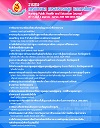การประยุกต์แบบแผนความเชื่อด้านสุขภาพเพื่อส่งเสริมการตรวจคัดกรองมะเร็งปากมดลูกของสตรีอายุ 30-60 ปี ดำเนินการโดยอาสาสมัครสาธารณสุขสตรี
คำสำคัญ:
การตรวจคัดกรองมะเร็งปากมดลูก, อาสาสมัครสาธารณสุขสตรี, ทฤษฎีแบบแผนความเชื่อด้านสุขภาพ, การสื่อสารเพื่อการโน้มน้าวใจ, CERVICAL CANCER SCREENING, WOMEN HEALTH VOLUNTEER, HEALTH BELIEF MODEL, PERSUASIVE COMMUNICATIONบทคัดย่อ
การเข้ารับการตรวจคัดกรองมะเร็งปากมดลูกของสตรีกลุ่มเป้าหมาย อายุ 30-60 ปี จะช่วยลดอุบัติการณ์ของโรคมะเร็งปากมดลูกลงได้ การวิจัยกึ่งทดลองนี้เพื่อศึกษาผลของโปรแกรมสุขศึกษาที่ประยุกต์แบบแผนความเชื่อด้านสุขภาพร่วมกับการสื่อสารเพื่อการโน้มน้าวใจ ดำเนินการโดยอาสาสมัครสาธารณสุขสตรีในเขตพื้นที่รับผิดชอบของโรงพยาบาลส่งเสริมสุขภาพตำบลท่าเสา อำเภอกระทุ่มแบน จังหวัดสมุทรสาคร จำนวน 80 คน แบ่งเป็น 2 กลุ่มจำนวนเท่ากัน กลุ่มทดลองได้เข้าร่วมโปรแกรมสุขศึกษา จำนวน 4 ครั้ง เป็นระยะเวลา 4 สัปดาห์ รวบรวมข้อมูลก่อนและหลังโปรแกรมด้วยแบบสัมภาษณ์ วิเคราะห์ข้อมูลด้วยสถิติ จำนวน ร้อยละ ค่าเฉลี่ย Paired Sample t-test , Independent’s t-test และ z-test
ภายหลังเสร็จสิ้นโปรแกรม พบว่า สตรีกลุ่มทดลองมีคะแนนเฉลี่ยการรับรู้โอกาสเสี่ยงต่อการเกิดโรคมะเร็งปากมดลูก การรับรู้ความรุนแรงของโรคมะเร็งปากมดลูก และการรับรู้ประโยชน์ของการเข้ารับการตรวจคัดกรองมะเร็งปากมดลูกสูงกว่าก่อนเข้าร่วมโปรแกรม และสูงกว่ากลุ่มเปรียบเทียบอย่างมีนัยสำคัญทางสถิติที่ระดับความเชื่อมั่น 95% สำหรับการรับรู้อุปสรรคต่อการไปรับการตรวจคัดกรองมะเร็งปากมดลูกลดลงกว่าก่อนการทดลอง และลดลงกว่ากลุ่มเปรียบเทียบอย่างมีนัยสำคัญทางสถิติที่ระดับความเชื่อมั่น 95% นอกจากนี้สตรีกลุ่มทดลองมาเข้ารับการตรวจคัดกรองมะเร็งปากมดลูกในสัดส่วนที่มากกว่ากลุ่มเปรียบเทียบอย่างมีนัยสำคัญทางสถิติที่ระดับความเชื่อมั่น 95% แสดงให้เห็นประสิทธิผลของโปรแกรมสุขศึกษาที่ประยุกต์แบบแผนความเชื่อด้านสุขภาพร่วมกับการเชิญชวนโน้มน้าวใจโดยอาสาสมัครสาธารณสุขสตรี ซึ่งเป็นผู้ที่มีความคุ้นเคยและสามารถสื่อสารได้ชัดเจนกับสตรีกลุ่มเป้าหมายในพื้นที่ ดังนั้น โปรแกรมสุขศึกษานี้จึงสามารถนำไปประยุกต์ใช้กับโรงพยาบาลส่งเสริมสุขภาพตำบลที่มีบริบทคล้ายคลึงกันได้ จะทำให้การเข้าถึงสตรีกลุ่มเป้าหมายได้มากขึ้น ลดความกลัว ความอาย และเพิ่มอัตราการคัดกรองมะเร็งปากมดลูก
THE APPLICATION OF HEALTH BELIEF MODEL TO PROMOTE CERVICAL CANCER SCREENING AMONG WOMEN AGED 30-60 YEARS PERFORMED BY WOMEN HEALTH VOLUNTEER.
Getting cervical cancer screening among the target group of women, aged 30-60 years, will help to lower the incidence of cervical cancer. This quasi-experimental research was aimed to assess the effect of a health education program applying health belief model and persuasive communication principles. The program was performed by women health volunteers with 80 sampled women in the areas responsible by Ta-soa Subdistrict Health Promotion Hospital Kratumbaen District, Samutsakorn Province. The samples were divided into 2 groups, 40 women each. The experimental group has participated in the health education program developed for 4 times, for the duration of 4 weeks. Data were collected before and after the program by using the interview schedule. The following statistics were used for data analysis : frequency, percentage, arithmetic mean, Paired Sample t-test, Independent t-test and Z-test.
After the program, it was found that the experimental group had significantly higher mean scores of perceived susceptibility of getting cervical cancer, perceived severity of cervical cancer, and perceived benefits of getting cervical cancer screening than before the program and than the comparison group (p<0.05). In regard to perceived obstacles of getting cervical cancer screening, significantly decreased mean score of the experimental group was found compared to before the program and the comparison group (p<0.05). Besides, significantly higher proportion of the women who received cervical cancer screening in the experimental group was found compared to the comparison group (p<0.05). The findings showed that the health education program applying health belief model and persuasive communication, and implemented by women health volunteer who were acquainted with and could communicate explicitly with the target group. Thus, this type of program can be utilized in other similar Subdistrict Health Promotion Hospitals in order to reach higher number of the target women, lower fear and shyness and to increase cervical cancer screening rate.



